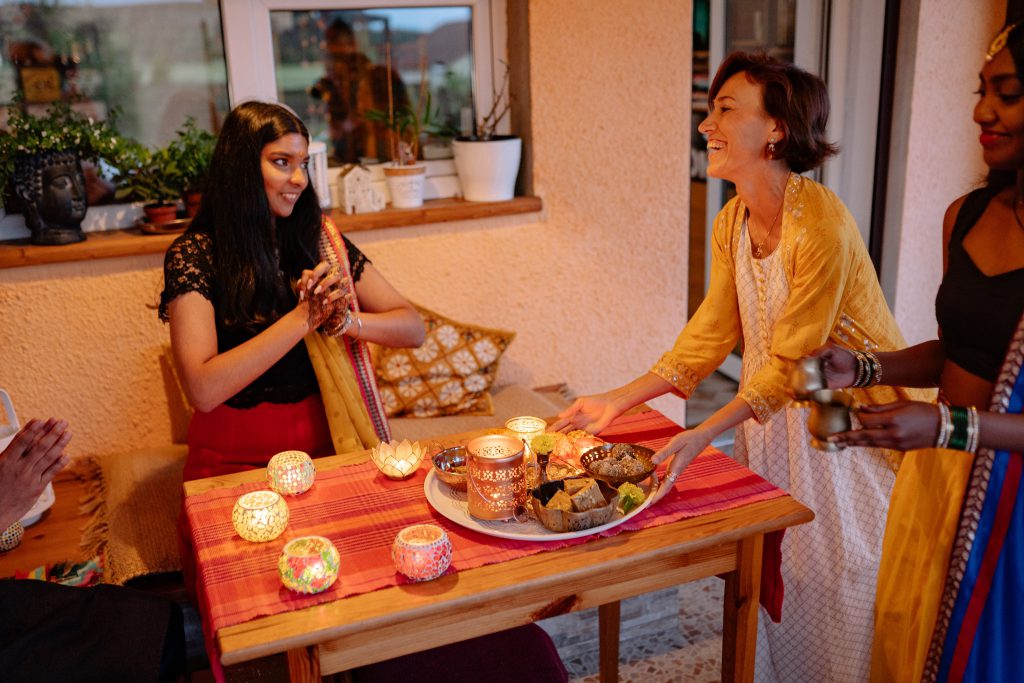
Diwali is a wonderful celebration and some find the special foods make it an even more enjoyable time. If you or someone you care for has a bowel stoma you may be adapting your meals and snacks to help manage gut symptoms. Everyone’s gut tolerance is different and if you have a colostomy you may find you haven’t needed to change your diet much. On the other hand, some people notice there are particular food triggers for looser stools, stoma pouch inflating and increased odours. To help you enjoy the festivities we’ve given suggestions on ingredients that could be potential triggers for gut symptoms, some foods you’ll find them in, and how to adjust their recipes to help your digestion. Happy Diwali!
Notes: To help write the following advice, we’ve spoken to people who celebrate Diwali. If you’d like us to mention other foods, or if you feel we haven’t gotten something quite right, please let us know.
The advice we provide doesn’t replace tailored diet advice from your healthcare professional.
- Whole nuts: These may be tougher to digest and loosen stools or increase the risk of a blockage. Chevda is often made with nuts, and may also include dried fruit and chickpeas which can also be tricky for those with bowel stomas.
To still get a crunchy texture, you can replace the nuts, dried fruit, and chickpeas with roasted vegetable crisps. To make them yourself you could finely slice some vegetables and coat in a little oil before roasting them – using carrot and parsnip will add a subtle sweetness to your chevda.
- Chopped nuts: Some might be able to digest foods with these in easier than those with whole nuts. Dishes like rasmalai, kalakand, laddoo, and ghughra often contain them.
Ground nuts (also known as nut powder or flour) and nut butter are often easier for the gut to manage. The ground nuts can be used as a topping for rasmalai or added into the kalakand before cooking. You could use nut butter as part of the filling for ghughra.
- Onions and garlic: These can increase pouch odours and may cause pouch inflating. Samosas and Bhajis usually contain finely chopped or grated onion, many dishes like dhaal and paneer makhani include garlic for flavour.
You may find that you can manage 1 or 2 samosas or bhaji if chewed well and had with a small glass of water. If making them yourself, you can blend the onion before adding them to the samosa pastry.
While cooking, you can swap garlic for asafoetida powder (available at most supermarkets) to get a similar flavour.
- Chickpeas, lentils, and beans: Their soluble fibre can thicken stoma outputs, but if lots are eaten then their insoluble fibre may contribute to looser stools and pouch inflating.
If making channa bhatura, you can ensure the chickpeas are cooked until they’re very soft and slightly mash them into the channa sauce. You can do something similar with dal dishes. Foods like mathiya papad and idli already have blended lentils or beans and so they should be well digested by many.
- Peas and spinach: Eating lots of these may cause looser stools and increase the risk of blockages. You may find you can manage a little of these foods when they’re chewed very well.
If adding to samosas, you can blend these ingredients first. If making muthiya or similar foods, you could swap to some easier to digest vegetables like the heads of cauliflower, peeled courgette/aubergine/swede.
- Chilli: As it moves through your body it can irritate the digestive system, possibly causing loose stools and some pain at your stoma site. This is more likely to happen in the 6-8 weeks after your stoma surgery while you’re still healing.
To see how chilli much you can manage while staying well it’s best to start with a small amount and slowly increase over a few days. If you’re worried about missing the ‘heat’ from chilli, having another strong flavour could help you feel like you’re not missing out. You might like to have a strong mug of ginger tea while eating your snacks, perhaps adding freshly grated ginger or black pepper to savoury dishes.
Our Top Tips
- Aim to chew your food very well and take your time eating
- Anything that doesn’t require much chewing will likely be fairly easy to digest
- Many foods that have tougher to digest ingredients may be tolerated in small amounts
- You may want to pick only 1 or 2 of these foods to have in the day to not overwhelm your gut
- Try to grill, bake, dry fry, or use an air fryer machine rather than deep frying where possible
- If you’re sensitive to onion or garlic you might like to substitute them during cooking for asafoetida powder
- Try to have minimal chilli unless it’s been 6-8 weeks after your stoma formation surgery and/or you know your gut and stoma feel ok after having it
Further support
For extra nutrition advice, you may find our nutrition guide and recipe booklets helpful. https://www.fittleworth.com/ostomates-kitchen/
If you’d like tailored advice, your hospital team can likely refer you to their specialist dietitian. You can also self-refer to a private practice dietitian on the Freelance Dietitians website. https://freelancedietitians.org/
———————————————————–
Laura Coster is a Registered Dietitian who is passionate about helping people feel confident in managing their health and find joy through what they eat.

